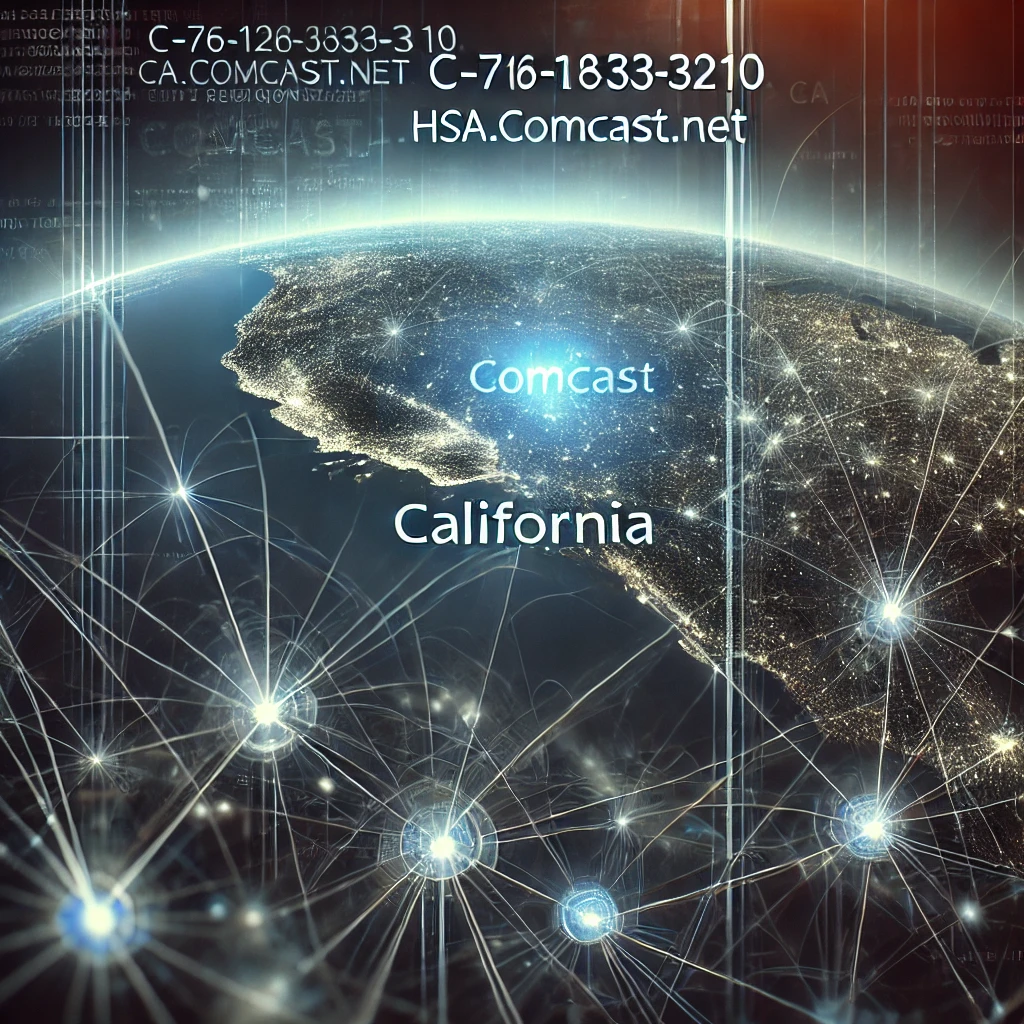vEver wondered what’s behind the strings of numbers and letters like c-76-126-33-210.hsd1.ca.comcast.net that you see in your network settings or on your router’s dashboard?
This identifier, commonly known as a hostname, tells us a lot more than meets the eye.
In simple terms, c-76-126-33-210.hsd1.ca.comcast.net is a unique label assigned to an IP address by Comcast, a major U.S. internet provider.
Think of it like an address on the internet where one device “lives” – letting data find its way there, sort of like how mail gets delivered to your street address.
Breaking Down c-76-126-33-210.hsd1.ca.comcast.net
Understanding this type of hostname isn’t as intimidating as it might look.
Each part actually tells us something about the internet connection, service location, and provider. Let’s go through it step by step:
- “c” – This usually designates a Comcast customer device. So, if you’re seeing this in your settings, it’s because you’re connected via Comcast.
- Numbers 76.126.33.210 – These numbers represent the IP address.
It’s a unique number for each device on the network, allowing other devices and websites to find it. - “hsd1” – This tag usually means high-speed data (HSD), and the “1” often identifies the region Comcast assigns this service in.
- “ca” – This one’s pretty straightforward: it stands for California.
ISPs like Comcast use region identifiers to help manage their networks more efficiently. - “comcast.net” – No surprise here; this tells us the hostname is managed by Comcast’s network.

Why Should I Care About My Hostname?
Good question!
Most people never really think about hostnames unless they’re trying to troubleshoot network issues, optimize their internet speeds, or improve their privacy.
Here’s why understanding a hostname like c-76-126-33-210.hsd1.ca.comcast.net could be useful for you:
- Network Troubleshooting: When your internet connection is lagging or failing, checking your hostname can give clues about the issue’s source.
- Privacy: Hostnames can reveal your general location and service provider, which can sometimes impact your online privacy.
For privacy-sensitive users, there are ways to mask or change these identifiers. - Diagnostics: Tech-savvy users and network administrators often use hostnames to track network performance, pinpointing issues to specific devices.
Real-Life Example: Why Your Hostname Can Matter
Imagine you’re having trouble with your streaming service constantly buffering.
You check your device settings, and you see c-76-126-33-210.hsd1.ca.comcast.net as the hostname.
Knowing this means you’re connected through Comcast’s network in California, you could then:
- Confirm there’s no ISP outage in your area by calling Comcast or visiting their support page.
- Test your internet connection speed using sites like Speedtest.net or Fast.com.
- Find network issues specific to Comcast in California on sites like Downdetector, which tracks ISP and service outages.
By linking your hostname to your network provider and location, you get a clearer picture of where issues might originate.
How Does Your Hostname Affect Security?
For most everyday users, hostnames like c-76-126-33-210.hsd1.ca.comcast.net don’t pose a serious security risk on their own.
But for businesses or anyone concerned with privacy, hostnames can hint at your location and ISP, which might be a factor if you’re handling sensitive data.
To boost privacy, here are a few simple tips:
- Use a VPN: A VPN masks your IP address and hostname, making your online activities less traceable.
- Consider Dynamic IP: Comcast typically offers dynamic IPs, meaning your IP and hostname will change periodically. This can add a layer of privacy.
- Check Your Router: Regularly update your router’s firmware. Older firmware can make you more vulnerable to attacks.
FAQs About Hostnames and Network Privacy
Q: Can I change my hostname?
A: In most cases, not directly. Comcast assigns your hostname based on your IP, but you can mask it using a VPN.
Q: Does c-76-126-33-210.hsd1.ca.comcast.net impact my browsing speed?
A: No, the hostname itself doesn’t affect speed, but the network it’s tied to might. If Comcast is experiencing high traffic in California, you might notice slower speeds.
Q: Why do websites or devices display hostnames instead of IPs?
A: Hostnames are easier for humans to understand, as they often include readable information like the ISP and region.
How Hostnames Like This Can Affect Your Internet Experience
Ever noticed that sometimes certain websites take ages to load, while others load in a snap?
Sometimes, this can be related to the specific server network your hostname is routed through.
If you’re in California and trying to access a server based in another country, your data has to travel farther, potentially slowing things down.
Here’s what you can do to improve your experience:
- Use Local Servers: When possible, choose websites or services with servers close to your region.
- Optimize Your Router Settings: Basic tweaks like setting your DNS to a faster service (like Google DNS or Cloudflare) can improve connection times.
- Monitor Network Congestion: Comcast and other ISPs often experience peak times.
Avoid heavy internet use during these times if possible for better performance.
Fun Fact: Hostnames and Geo-Targeted Content
Your hostname can also play a role in the kind of content you see online.
Since c-76-126-33-210.hsd1.ca.comcast.net hints at a California location, some websites might serve you California-specific ads or content.
Ever noticed seeing local ads when you’re browsing?
This is one way advertisers target based on your general region, all from that little hostname.
What If I Don’t Want My Location Revealed?
There are a few easy ways to maintain more privacy online without drastically changing your setup:
- Enable Private Browsing: Use incognito or private browsing modes.
- Use Browser Extensions: Privacy-focused extensions like Privacy Badger or uBlock Origin block tracking and ads.
- Consider Alternative ISPs: Some ISPs offer more control over your data privacy, though options may be limited depending on your area.

What Does My ISP See with Hostnames Like This?
Your ISP, in this case, Comcast, can see quite a bit with your hostname and related data.
They can log your browsing activity, collect data for advertising, and potentially share it with third parties (though Comcast adheres to privacy policies).
If privacy is a big deal for you, take these extra steps:
- Check Comcast’s Privacy Policy: Find out what data they collect and how they use it.
- Consider Encryption: Use secure HTTPS sites for extra privacy.
- Ask for Transparency: Contact Comcast directly to clarify data use, which can be helpful if you’re looking to manage your data footprint.
Final Thoughts on c-76-126-33-210.hsd1.ca.comcast.net
Understanding a hostname like c-76-126-33-210.hsd1.ca.comcast.net can help you make informed choices about your network and privacy.
It’s not just random characters and numbers; it’s a window into your network setup, ISP, and location.
With a few small steps, you can optimize your internet experience and even add layers of privacy.
Take control of your network knowledge and feel confident about the data journey behind the scenes.

